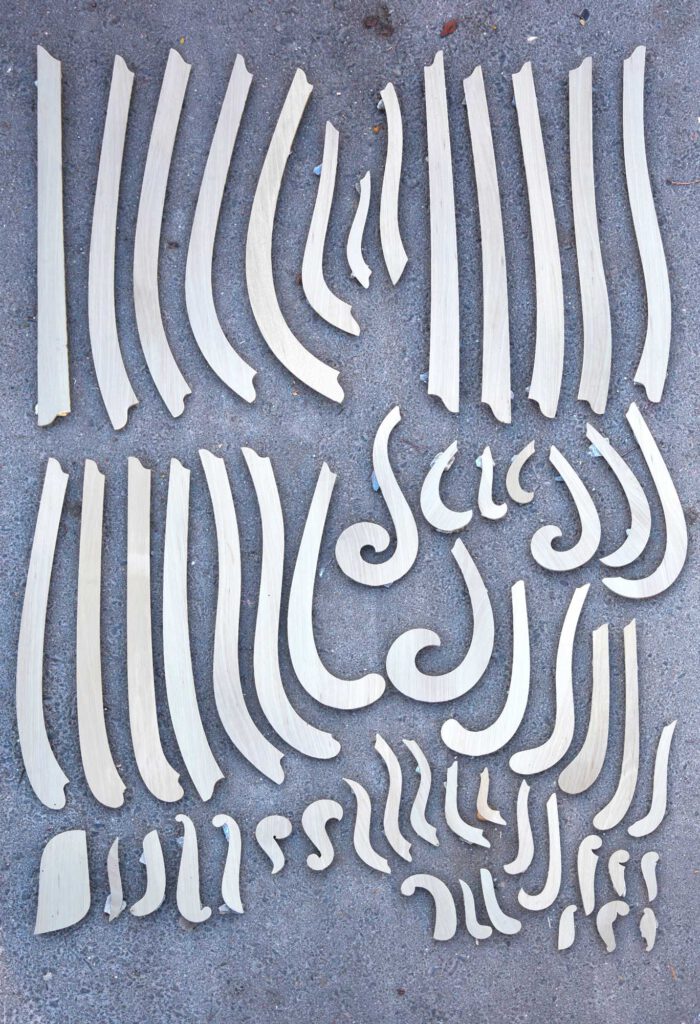
I am interested in the area of tension between sameness and difference.
I am using a set a of Copenhagen Ship Curves.
The templates form a set of an extremely wide range of different curves, which is nevertheless restricted. So that despite these almost endless possibilties of curves, one can still see a sort of common ground.
But what connects them is not that common ground. It is not their sameness.
What brings them together as a set, is the difference inbetween them. These differences between the curves form a tension that divides them in a way that their otherness is realised and that at the same time connects them in a way that two different curves pull at the space inbetween them.
These curves are not forms but forces.
There is no single person, who invented them. They are not mathematical curves, there is no science in the strictest sense of the word involved.
They developed hundreds of years ago out of actual want. Boats had to be drawn and the makers -the draughtspersons developped their own curves to do so. Over time and mutual exchange, through copying, adding and leaving out, a few „standard“ sets rather grew than were invented. Whereas „standard“ is a rather odd word here, since it not strictly defined which curves must be in a set and how they exactly look like.
These specific templates here .. i made them myself. I used drawings and photographes of a set of copenhagen ship curves from the 19th century and drew them anew. I transferred the drawing to pieces of wood, cut those out and planed them to their final shape. So the actual curves here do not exactly match with the drawings and photographes and also not with the curves, a draughtsperson made in the 19th century or in the 20th. These templates here were created by the corresponding movements of my body, the planer and the line on the piece of wood, as well. Every actual template of this set was always very particular. Doesnt that put an interesting light on the authorship of my set of ship curves? Isnt this set now a collective-particular event that ignores time and space and (nevertheless) manifests itself?
They make me perform. These Shipcurves are tools, made to be put into action.
They are performative. They make me act. As a thing, they highly influence my decisions and movements. And I as an artist or a researcher or whatever, I want to find out more about how things act and how they make me or somebody else act. That is why i am so interested by processes. And manifestations of processes. On a material level you cannot understand these templates other then being in use. You do not (only) understand them by context but by their correspondance with other actors. They are processual signs.
By using the templates, by putting them into action, i am put into action by them as well. From one perspective they transmit to my body and I become the medium, the thing inbetween.
What does that mean? Well, it could mean that i am actually the screen, the material through which ways of thinking can transfer from one field to another. From the material level of physical forces and characteristics, to maybe the field of social forces and characteristics. Of how the relation of the particular to the universal is in the usage of the shipcurves to how gender can be socially contructed despite everyone is so different and individual? (-sarcastic).
Do you find this to far off? Well then, how far can an analogy go? How similar or different must things be to compare them, to put them into relation?
I think, analogies should open up defects that leak. From which the unpredictable flows as an assumption about the missing that does not want to be satisfied.
Possible method for transfer: 1. discover analogies, 2. pinch eyes – let everything blur, 3. place this blurred image over the other field, 4. look for overlaps, misalignments, intensities and so on, (5. focus).